
Fantasy and frauds: What Azerbaijan’s place is based on in WEF competitiveness rankings...
Days ago the head of the political analysis and information provision of the Presidential Administration of Azerbaijan Elnur Aslanov gave an interview to the Azerbaijani news agency "APA", and made several false thesis.
Thus, commenting on the new report from the World Economic Forum, according to which Azerbaijan took the 39th position in the "Global Competitiveness Index for 2013-2014," Aslanov stated, "Looking at the figures you will see that, the volume of oil and gas per capita in Iran is 2.5-3 times higher than in Azerbaijan, 1.7 times higher than in Kazakhstan and 1.3 times greater than in Russia.
However, by the competitiveness Azerbaijan is ahead of these three countries. Consequently, Azerbaijan uses its oil and gas resources more rationally than these countries."
However, Elnur Aslanov misinformed the readers. The thing is that according to the data of 2012 Iran produces about 2.7 million barrels of oil per day, which equals to 134.4 tons per year. In per capita terms it amounts to 1.7 tons per person. 43 million tons of oil was produced in Azerbaijan in 2012, while the republic's population is officially declared as 9.3 million people. Thus, according to Baku official data 4.3 tons of oil is produced per citizen in, Azerbaijan. The analogous index in other countries mentioned by Elnur Aslanov is also less than that of Azerbaijan: Kazakhstan produces 3.9 tons per person, and Russia - 3.6 tones.
At the same time, it should be taken into consideration that the actual population of Azerbaijan is less than 6 million, as media has repeatedly mentioned. If we emanate from the real data, 7.3 tons of oil is produced for per citizen in Azerbaijan. This explains Azerbaijan’s position in the ranking. Thus, we can say that the places of the countries highlighted by Aslanov in the ranking are directly correlated to the amount of oil production per citizen.
As for the volume of gas in terms of a citizen, Azerbaijan (3 million cubic meters per capita) slightly exceeds Iran and Kazakhstan (2.3 million cubic meters per capita) but is slightly inferior to Russia. However, if we consider the real population of Azerbaijan, these indicators with Russia and Azerbaijan are equal (4.5 million cubic meters per capita). On the whole, the amount of revenue from the sale of oil is higher than in the gas sector, which eliminates minor discrepancies indicators of gas production.
Another important component of Baku’s "success" in this rating is the ninefold inflation data falsifications, and this figure is one of the key figures while forming the rating.
Thus, the expert of Public Association of Assistance to Economic Initiatives Samir Aliyev said that the Azerbaijani authorities understate the rate of inflation artificially. According to the Azerbaijani news agency "Turan", in 2012, the Azerbaijani authorities have reduced the inflation rate for 9 times. Chairman of the Center for Economic Research (CER), Doctor of Economic Sciences Gubad Ibadoglu also stated that the data of the Azerbaijani authorities on the inflation rate (1.1%) are fabulous. Realistically, according to alternative estimations of CER the inflation in Azerbaijan reached 9.92%, at the same time the food inflation reached to 18%. He also noted that the State Statistics Committee of Azerbaijan estimates the figures just as the political power requires.
Elnur Aslanov also stated, "The economy of Armenia and Georgia is only the 70% of non-oil sector of Azerbaijan." If we base on the data of Azerbaijani statistics, then Elnur Aslanov is likely telling the truth. However, as shown above, Azerbaijani experts repeatedly point out on the fact that the Azerbaijani statistics "draw" the figures necessary to the leadership of the republic, which sometimes is too far from reality.
One can make an easy estimation of the real volume of non-oil economy of Azerbaijan and its competitiveness level—compare the non-oil export of Azerbaijan, Armenia and Georgia. It turns out that Azerbaijan’s export excluding the oil and gas sphere is about 1.65 bln US dollars. It is interesting to note that the oil economy of Azerbaijan (36.2 bln US dollars), which seems “big” on paper, is able to send only about 1.65 bln US dollars for export or 4.5 percent of all the export value.
To compare, Armenia’s export makes about 1.38 bln US dollars or 13.9 percent of GDP while, if we believe in the figures of Azerbaijan’s State Statistics Committee, the population of its republic exceeds Armenia’s population by three times, non-oil economy 3.6 times and export only by 19 percent. Here, the Azerbaijan’s officials have to admit that their non-oil economy is very inefficient compared to Armenian’s economy or to accept that their non-oil economy is a bubble blown on a paper, while in reality Azerbaijan’s economy is many times smaller. As for Georgia, the exports of Georgia in 2012 were about 2.37 bln US dollars or 15 percent of GDP (15.8 bln US dollars).
Newsfeed
Videos






























